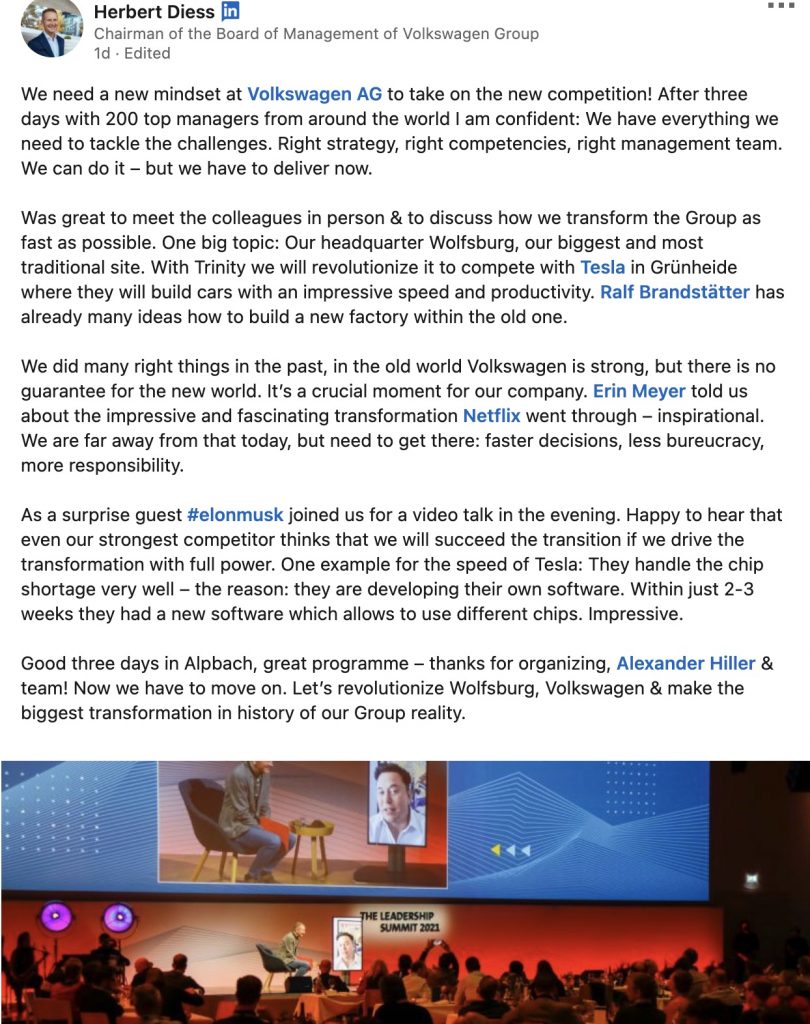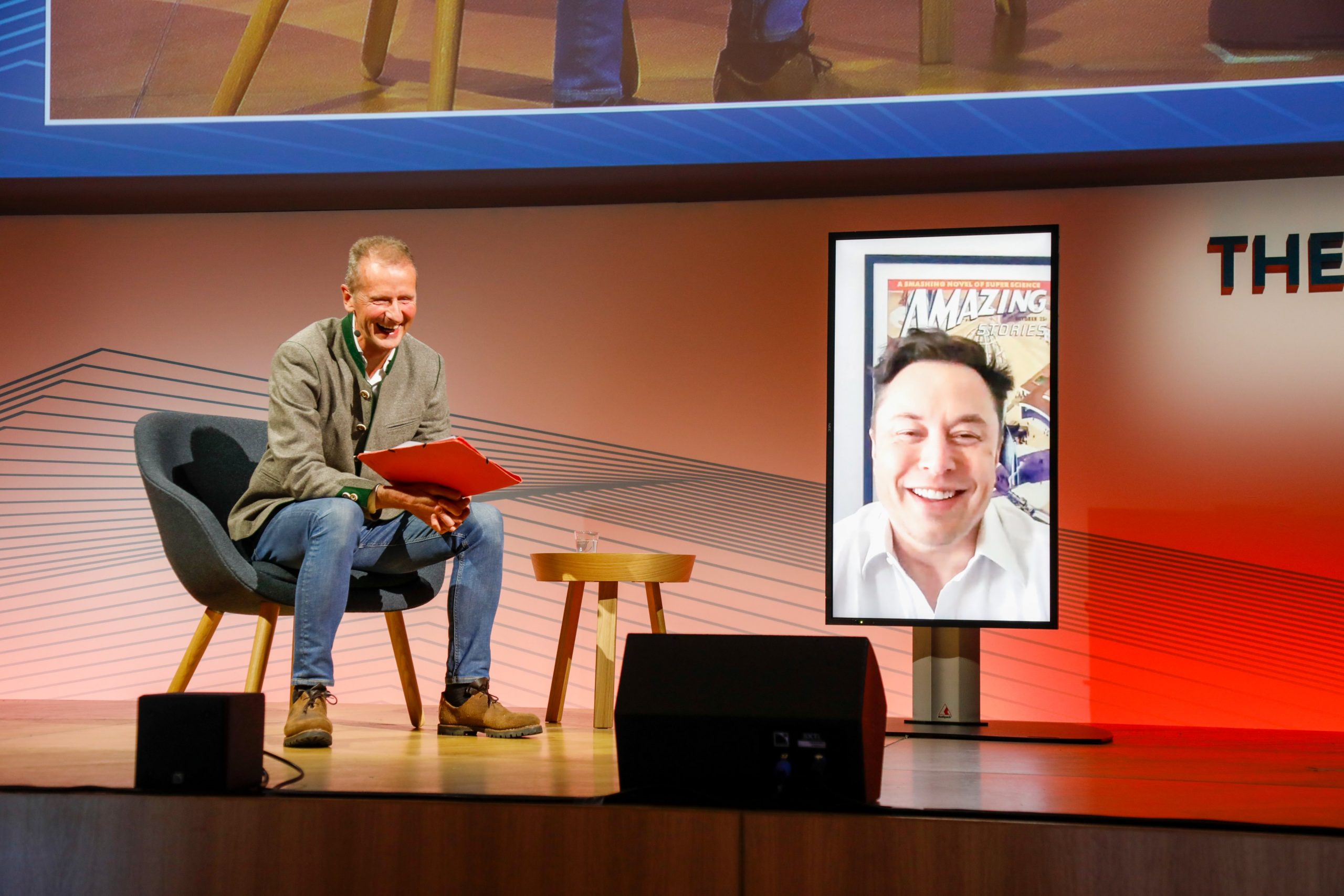The Elon Musk and Herbert Diess budding bromance seems to be going strong, with the Tesla CEO making a surprise appearance at the Volkswagen managers’ 2021 Leadership Summit in Alpbach, Austria.
Elon Musk’s attendance at the VW Group gathering reveals Diess and the Tesla CEO’s deep respect for each other. Musk’s appearance also shows that Diess is willing to change his mindset, something that he believes everyone at Volkswagen AG needs to go through to compete with new automakers.
“We need a new mindset at Volkswagen AG to take on the new competition!” posted Herbert Diess on LinkedIn. “After three days with 200 top managers from the world, I am confident: We have everything we need to tackle the challenges. Right strategy, right competencies, right management team. We can do it—but we have to deliver now.”
It seems like Diess invited Elon Musk to speak at the summit to learn from Tesla’s CEO and gain some perspective. According to Handelsblatt, Diess asked Musk why Tesla was so nimble compared to its rivals.
The Tesla CEO replied that it came down to his management style and how he thought of himself. Musk shared that he perceived himself as an engineer, first and foremost, one that has an eye for supply chains, logistics, and production.
Musk may have given Diess and VW managers some encouraging words at the meeting as well, assuring everyone that they were moving in the right direction.
“As a surprise guest [Elon Musk] joined us for a video talk in the evening. Happy to hear that even our strongest competitor thinks that we will succeed in the transition if we drive the transformation with full power,” Diess noted.

VW’s Electric Future
In a LinkedIn post, Diess mentioned VW Group’s headquarters in Wolfsburg and Project Trinity. The Wolfsburg plant has long been one of VW’s key facilities. Project Trinity is VW’s upcoming electric sedan project, and it will be built in the Wolfsburg plant. The company aims to start Project Trinity production at Wolfsburg by 2026.
According to VW CEO Ralf Ralf Brandstätter, Project Trinity is like the point of “crystallization” for the legacy OEM’s ACCELERATE strategy. VW Group plans to “accelerate” its transformation into a software-driven mobility provider, and Project Trinity seems to be an integral part of the company’s evolution.
VW and Tesla’s Healthy Competition
Diess noted that Project Trinity could revolutionize the company. He observed that Trinity could help Volkswagen compete with Tesla Giga Berlin in Grünheide, highlighting that Tesla Giga Berlin “will build cars with an impressive speed and productivity.”
At Giga Fest, a poster stated that Giga Berlin aims to produce one car body every 45 seconds, hinting at how many cars Giga Berlin could make in the future. The sign did not indicate whether the goal was short-term or long-term.
However, it has been reiterated repeatedly that one of Tesla’s early goals for Giga Berlin is to produce 500,000 vehicles a year. Since Giga Berlin’s goal has been made public, Volkswagen Group has a clear EV production goal to compete with Tesla in Grünheide.
The Teslarati team would appreciate hearing from you. If you have any tips, reach out to me at maria@teslarati.com or via Twitter @Writer_01001101

News
Elon Musk’s Grokipedia surges to 5.6M articles, almost 79% of English Wikipedia
The explosive growth marks a major milestone for the AI-powered online encyclopedia, which was launched by Elon Musk’s xAI just months ago.

Elon Musk’s Grokipedia has grown to an impressive 5,615,201 articles as of today, closing in on 79% of the English Wikipedia’s current total of 7,119,376 articles.
The explosive growth marks a major milestone for the AI-powered online encyclopedia, which was launched by Elon Musk’s xAI just months ago. Needless to say, it would only be a matter of time before Grokipedia exceeds English Wikipedia in sheer volume.
Grokipedia’s rapid growth
xAI’s vision for Grokipedia emphasizes neutrality, while Grok’s reasoning capabilities allow for fast drafting and fact-checking. When Elon Musk announced the initiative in late September 2025, he noted that Grokipedia would be an improvement to Wikipedia because it would be designed to avoid bias.
At the time, Musk noted that Grokipedia “is a necessary step towards the xAI goal of understanding the Universe.”
Grokipedia was launched in late October, and while xAI was careful to list it only as Version 0.1 at the time, the online encyclopedia immediately earned praise. Wikipedia co-founder Larry Sanger highlighted the project’s innovative approach, noting how it leverages AI to fill knowledge gaps and enable rapid updates. Netizens also observed how Grokipedia tends to present articles in a more objective manner compared to Wikipedia, which is edited by humans.
Elon Musk’s ambitious plans
With 5,615,201 total articles, Grokipedia has now grown to almost 79% of English Wikipedia’s article base. This is incredibly quick, though Grokipedia remains text-only for now. xAI, for its part, has now updated the online encyclopedia’s iteration to v0.2.
Elon Musk has shared bold ideas for Grokipedia, including sending a record of the entire knowledge base to space as part of xAI’s mission to preserve and expand human understanding. At some point, Musk stated that Grokipedia will be renamed to Encyclopedia Galactica, and it will be sent to the cosmos.
“When Grokipedia is good enough (long way to go), we will change the name to Encyclopedia Galactica. It will be an open source distillation of all knowledge, including audio, images and video. Join xAI to help build the sci-fi version of the Library of Alexandria!” Musk wrote, adding in a later post that “Copies will be etched in stone and sent to the Moon, Mars and beyond. This time, it will not be lost.”
News
Tesla Model 3 becomes Netherlands’ best-selling used EV in 2025
More than one in ten second-hand electric cars sold in the country last year was a Tesla Model 3.

The Tesla Model 3 became the most popular used electric car in the Netherlands in 2025, cementing its dominance well beyond the country’s new-car market.
After years at the top of Dutch EV sales charts, the Model 3 now leads the country’s second-hand EV market by a wide margin, as record used-car purchases pushed electric vehicles further into the mainstream.
Model 3 takes a commanding lead
The Netherlands recorded more than 2.1 million used car sales last year, the highest level on record. Of those, roughly 4.8%, or about 102,000 vehicles, were electric. Within that growing segment, the Tesla Model 3 stood far ahead of its competitors.
In 2025 alone, 11,338 used Model 3s changed hands, giving the car an 11.1% share of the country’s entire used EV market. That means more than one in ten second-hand electric cars sold in the country last year was a Tesla Model 3, Auto Week Netherlands reported. The scale of its lead is striking: the gap between the Model 3 and the second-place finisher, the Volkswagen ID3, is more than 6,700 vehicles.
Rivals trail as residual values shape rankings
The Volkswagen ID.3 ranked a distant second, with 4,595 used units sold and a 4.5% market share. Close behind was the Audi e-tron, which placed third with 4,236 registrations. As noted by Auto Week Netherlands, relatively low residual values likely boosted the e-tron’s appeal in the used market, despite its higher original price.
Other strong performers included the Kia Niro, the Tesla Model Y, and the Hyundai Kona, highlighting continued demand for compact and midsize electric vehicles with proven range and reliability. No other model, however, came close to matching the Model 3’s scale or market presence.
News
Tesla Model Y Standard Long Range RWD launches in Europe
The update was announced by Tesla Europe & Middle East in a post on its official social media account on X.

Tesla has expanded the Model Y lineup in Europe with the introduction of the Standard Long Range RWD variant, which offers an impressive 657 km of WLTP range.
The update was announced by Tesla Europe & Middle East in a post on its official social media account on X.
Model Y Standard Long Range RWD Details
Tesla Europe & Middle East highlighted some of the Model Y Standard Long Range RWD’s most notable specs, from its 657 km of WLTP range to its 2,118 liters of cargo volume. More importantly, Tesla also noted that the newly released variant only consumes 12.7 kWh per 100 km, making it the most efficient Model Y to date.
The Model Y Standard provides a lower entry point for consumers who wish to enter the Tesla ecosystem at the lowest possible price. While the Model 3 Standard is still more affordable, some consumers might prefer the Model Y Standard due to its larger size and crossover form factor. The fact that the Model Y Standard is equipped with Tesla’s AI4 computer also makes it ready for FSD’s eventual rollout to the region.
Top Gear’s Model Y Standard review
Top Gear‘s recent review of the Tesla Model Y Standard highlighted some of the vehicle’s most notable features, such as its impressive real-world range, stellar infotainment system, and spacious interior. As per the publication, the Model Y Standard still retains a lot of what makes Tesla’s vehicles well-rounded, even if it’s been equipped with a simplified interior.
Top Gear compared the Model Y Standard to its rivals in the same segment. “The introduction of the Standard trim brings the Model Y in line with the entry price of most of its closest competition. In fact, it’s actually cheaper than a Peugeot e-3008 and costs £5k less than an entry-level Audi Q4 e-tron. It also makes the Ford Mustang Mach-E look a little short with its higher entry price and worse range,” the publication wrote.










